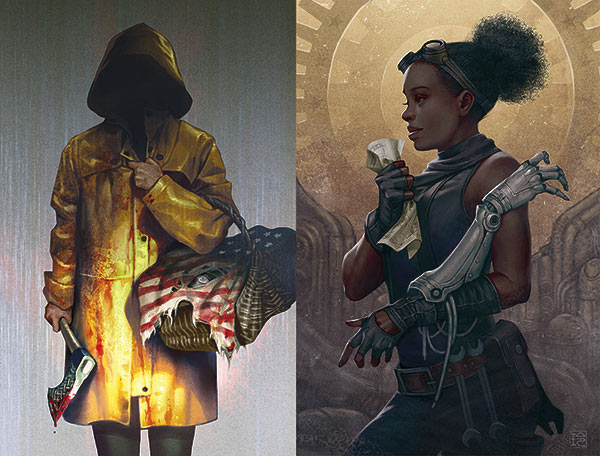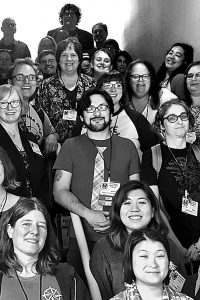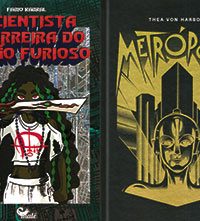Spotlight on: Reiko Murakami

Reiko Murakami is a US-based concept artist and illustrator specializing in surreal fantasy and horror art. With her subtle and expressive gesture drawings she focuses on capturing moments filled with unspeakable emotions. Her illustrations have appeared on many projects such as Tor.com, Magic: the Gathering, and Basketful of Heads (Hill House Comics, DC). Her work has been exhibited at Nucleus Portland, Helikon Gallery, Krabjab Studio, Light Grey Art Lab and published in art annuals Spectrum, Infected by Art, Exposé, and many others.
What was your introduction to working in the field of science fiction and fantasy art? Who were your influences; was there a particular artist or artists who drew you in?
My fantasy art career started when I attended the artist retreat called Illustration Master Class, organized by Rebecca Leveille (Guay). The mentors there opened the entirely new world of the SFF community of artists and Art Directors to me. Later, I took more personal online classes with some of the instructors including Scott Fischer and Rebecca herself, and their philosophy and process heavily influenced my workflow. Rebecca’s teaching and guidance still works as a beacon to me, even today.
Talk a bit about one of your most interesting cover projects. What’s it like to illustrate an author’s work? How do you engage with the work and make it your own while still honoring the source material?
To me, making a cover art is like writing an essay about the book. It is an expression of my interpretation of the nature of the story, only in a visual art form. I feel my work is successful when I can find a good ground in the book that I can resonate with at a deep and personal level. If it happens, I can execute the visuals with my artistic voice, which brings all of my strength in creating an image. So, when Irene Gallo from Tor gave me the story by Cheri Kamei, “Blood in the Thread”, I was very much excited. I’m Japanese American and this is a story from another Japanese American author, using Japanese folktale as a main motif. I felt I resonated well with extra deep understanding of the story. The result was very personally satisfying.
Are you excited or concerned about the impact digital media and digital books might have on traditional crafts and the role of the cover artist? How do you use digital media in your own workflow?
My background is as a video game artist. I used to work for game studios and everything we do in the industry is pretty much all published in digital media. I personally have no conflict in working with digital publishing or digital tools. As for my own work, most of my commercial work is done completely in Photoshop. (“Blood in the Thread”, “Flight”, and “Anything Resembling Love” are all done in traditional media, which is a rare case for my cover work.) While most of my mentors work in traditional media, such as oil, I learned the fundamental skills in creating good art are basically the same in both media. That said, although digital tools are much more convenient these days, I’d say the traditional tools will not go away, since a lot of us digital artists understand the importance of traditional skills when training to become better artists. Artists are still using traditional media to gain deeper understanding in the techniques we use in digital tools.

How do you keep it fresh for yourself and keep learning new techniques and improving your craft? Have there been any recent changes or discoveries in your art process, or do you feel settled into something that’s really working for you already?
Teaching younger generations gives me opportunities to get exposed to new tools and trends. Also, by preparing my lecture I actually learn a lot more deeply about my process. Because my main commercial tool is digital, I also get an update in new tech quite frequently. I’m at this point where I know what works well for my process, so the search for better digital tools and techniques are more focused and efficient these days.
Is there one thing you wish you could have learned early on about making art or working as a commercial artist, from someone who was experienced in the field?
I believe all that I went though, including struggles, were necessary steps to come to this point, so I don’t have regrets. However, I could’ve spent less energy struggling to be the best at everything. I learned it’s actually better to have specific strengths and weaknesses than being good all over. Strength and weakness are both equally important traits in our work. It gives us the definition of who we are. When I was able to embrace my weakness, I was finally able to see my strength. The work I did in the past when I was denying that I have weakness and pretending to paint like someone else, appears to be much weaker now since it’s not an honest piece and lacks my traits as an artist. If I was able to see this earlier I wouldn’t have to suffer that much.
Is there something about what you do as an artist working in the SF field, or an upcoming project, that you’d like to tell our readers about?
I was fortunate to illustrate N.K. Jemisin’s Inheritance trilogy (published by Subterranean Press). It was a great experience to work with her in depicting scenes and characters. Also, I’m currently working with Grady Hendrix to illustrate his books, including Horrorstör. These special edition books will be available from SST Publications. Grady and I are working closely to make the art very special, so please check it out!
–Reiko Murakami
This and more like it in the June 2021 issue of Locus.
 While you are here, please take a moment to support Locus with a one-time or recurring donation. We rely on reader donations to keep the magazine and site going, and would like to keep the site paywall free, but WE NEED YOUR FINANCIAL SUPPORT to continue quality coverage of the science fiction and fantasy field.
While you are here, please take a moment to support Locus with a one-time or recurring donation. We rely on reader donations to keep the magazine and site going, and would like to keep the site paywall free, but WE NEED YOUR FINANCIAL SUPPORT to continue quality coverage of the science fiction and fantasy field.
©Locus Magazine. Copyrighted material may not be republished without permission of LSFF.







